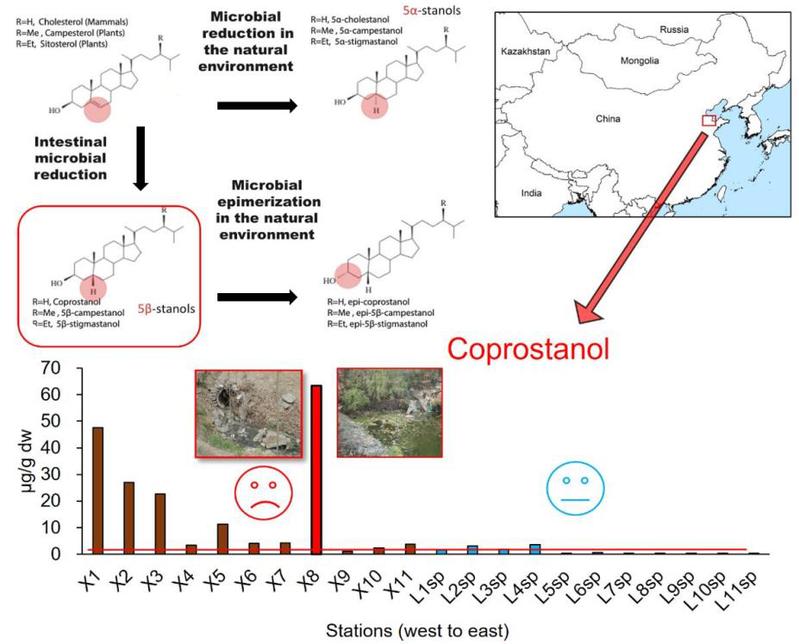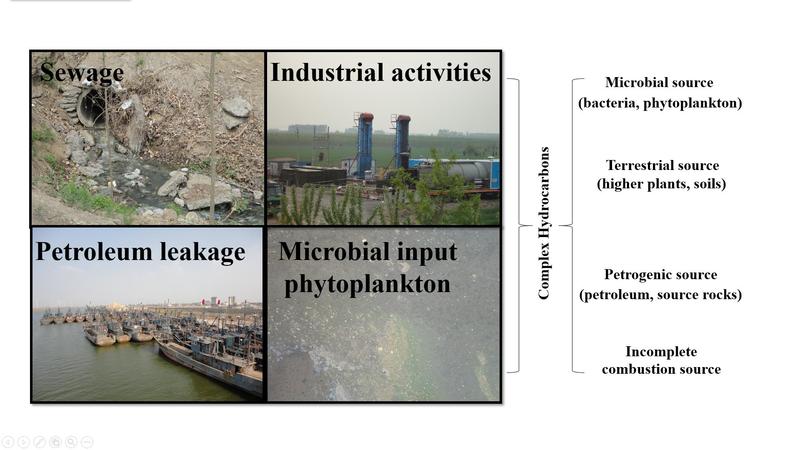Editor: 邵丹蕾 Author: He Ding Time: 2018-09-25 Number of visits :191

 The organic matter (OM) cycling between rivers and coastal ocean is poorly constrained due to difficulties in assessing composition of different OM sources. Sedimentary fecal sterols and multiple hydrocarbon biomarkers, combined with bulk total organic carbon (TOC), stable carbon isotopes, and multiple statistical analyses were applied to elucidate both natural and anthropogenic inputs and for the estimation of pollution levels across the Xiaoqing River to the Laizhou Bay, a typical river-estuary system subjected to extensive anthropogenic stress due to rapid regional urbanization and industrialization in eastern China (He et al., 2018a,b). Significant spatial instead of seasonal variation in fecal sterol concentrations observed. Higher sewage input observed in the Xiaoqing River than the Laizhou Bay. Although there was no significant difference in fecal sterol concentrations between spring and summer in the Laizhou Bay, fecal typical sterol based ratios suggested different sewage sources (e.g. human vs. non-human) between seasons (He et al., 2018b). Meanwhile, various hydrocarbons, including aliphatic and polycyclic aromatic hydrocarbons (PAHs), suggested the major part of hydrocarbons identified came from anthropogenic inputs including petroleum residues and synthetic detergents related hydrocarbons, followed by higher plant and microbial inputs (He et al., 2018b). Stronger phytoplankton and microbial derived hydrocarbons observed in summer than spring. Further principal component analyses suggested that the overall distribution of aliphatic hydrocarbons was mainly controlled by seasonality instead of spatiality. In contrast, noseasonal variation observed for PAHs composition. Physical processes such as atmospheric transportation and further deposition may be factors influencing the distribution of PAHs in the study area with widely biomass and fossil fuel burning. Our study suggested seasonal discharge and land-runoff, air temperature related to microbial activity differences and different extend of sewage input could be reasons affecting the composition of both natural and anthropogenic OM from rivers to coastal oceans.
The organic matter (OM) cycling between rivers and coastal ocean is poorly constrained due to difficulties in assessing composition of different OM sources. Sedimentary fecal sterols and multiple hydrocarbon biomarkers, combined with bulk total organic carbon (TOC), stable carbon isotopes, and multiple statistical analyses were applied to elucidate both natural and anthropogenic inputs and for the estimation of pollution levels across the Xiaoqing River to the Laizhou Bay, a typical river-estuary system subjected to extensive anthropogenic stress due to rapid regional urbanization and industrialization in eastern China (He et al., 2018a,b). Significant spatial instead of seasonal variation in fecal sterol concentrations observed. Higher sewage input observed in the Xiaoqing River than the Laizhou Bay. Although there was no significant difference in fecal sterol concentrations between spring and summer in the Laizhou Bay, fecal typical sterol based ratios suggested different sewage sources (e.g. human vs. non-human) between seasons (He et al., 2018b). Meanwhile, various hydrocarbons, including aliphatic and polycyclic aromatic hydrocarbons (PAHs), suggested the major part of hydrocarbons identified came from anthropogenic inputs including petroleum residues and synthetic detergents related hydrocarbons, followed by higher plant and microbial inputs (He et al., 2018b). Stronger phytoplankton and microbial derived hydrocarbons observed in summer than spring. Further principal component analyses suggested that the overall distribution of aliphatic hydrocarbons was mainly controlled by seasonality instead of spatiality. In contrast, noseasonal variation observed for PAHs composition. Physical processes such as atmospheric transportation and further deposition may be factors influencing the distribution of PAHs in the study area with widely biomass and fossil fuel burning. Our study suggested seasonal discharge and land-runoff, air temperature related to microbial activity differences and different extend of sewage input could be reasons affecting the composition of both natural and anthropogenic OM from rivers to coastal oceans.
References:
He, D., Zhang, K., Cui, X., Tang, J., Sun, Y. (2018a). Spatiotemporal variability of hydrocarbons in surface sediments from an intensively human-impacted Xiaoqing River-Laizhou Bay system in the eastern China: Occurrence, compositional profile and source apportionment. Science of the Total Environment, 645, 1172-1182.
He, D., Zhang, K., Tang, J., Cui, X., Sun, Y. (2018b). Using fecal sterols to assess dynamics of sewage input in sediments along a human-impacted river-estuary system in eastern China. Science of The Total Environment, 636, 787-797.
